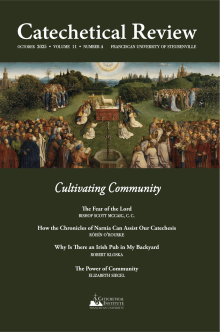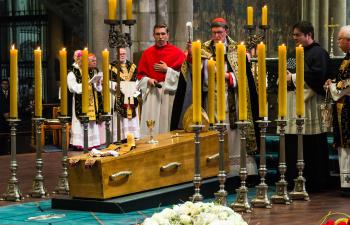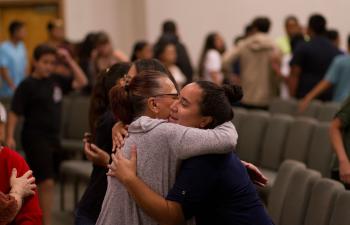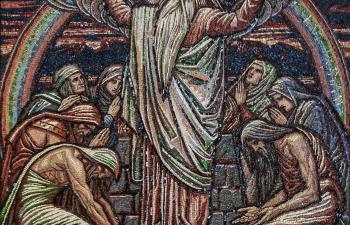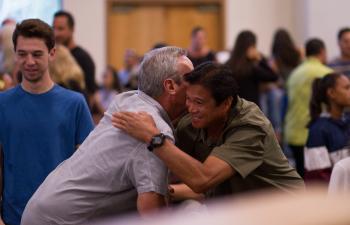 The catechist’s chief task is to teach the true, good, and beautiful, focusing on illuminating the splendor of the deposit of faith. There are moments, however, when the topic that needs to be taught is a truth knowable for the most part by reason in addition to being knowable fully by faith. At this current moment in history, a primary truth at stake is the sexual difference of man and woman. The topic presses itself from all sides. Full-scale rejections of the reality of man and woman or distorted, reductive proposals abound. Yet, as in all eras of Church history, when a truth is being called into question, the Church responds by means of an even deeper contemplation and joyful proclamation of the unchanging truth, now fleshly enlightened.
The catechist’s chief task is to teach the true, good, and beautiful, focusing on illuminating the splendor of the deposit of faith. There are moments, however, when the topic that needs to be taught is a truth knowable for the most part by reason in addition to being knowable fully by faith. At this current moment in history, a primary truth at stake is the sexual difference of man and woman. The topic presses itself from all sides. Full-scale rejections of the reality of man and woman or distorted, reductive proposals abound. Yet, as in all eras of Church history, when a truth is being called into question, the Church responds by means of an even deeper contemplation and joyful proclamation of the unchanging truth, now fleshly enlightened.
The Church’s current response to confusion regarding man and woman is being fueled by positive developments in theological anthropology that have occurred during the past century. At their core is the articulation of the nature of man and woman via the notion of complementarity. This notion has emerged as the primary way of describing the reciprocal relationship between man and woman and the ordering of both to an interpersonal communion of love. Pope St. John Paul II is the most prominent contemporary promoter, with “reciprocal complementarity” being his preferred way of describing man and woman.[1] Given the necessity for catechetical initiatives to include the teaching of God’s plan for man and woman, it behooves one to ask the crucial question: What does it mean to say that man and woman are reciprocally complementary? With John Paul II as our guide, we will outline key principles of sexual complementarity that teachers of the faith must know in order to effectively catechize and evangelize our modern world. In short, man and woman, who are equal yet significantly different, are complementary because they are made for each other and for the fruitful expansion of love.[2] We will conclude by indicating a few points regarding man–woman complementarity and the new evangelization.
The Common Humanity and Equal Dignity of Man and Woman
The first and foundational principle of the complementarity of man and woman is their fundamental equality. Both are fully human persons; each one is an “I,” a someone not something, created in the image and likeness of God (Gn 1:26–27), willed for his or her own sake, created for eternal communion with God. Man and woman have the same rational human nature, involving an intellect and will, with all the concomitant essential properties that pertain to this nature (a soul as substantial form in hylomorphic unity with the material body). John Paul II affirms: “Woman complements man, just as man complements woman: men and women are complementary. Womanhood expresses the ‘human’ as much as manhood does, but in a different and complementary way.”[3]
Complementarity in general presupposes equality. For example, two nations’ economies can be complementary because both are nations, or two musical instruments can play together complementarily because both are musical instruments. This is even more true with human sexual complementarity: there can only be a mutual correspondence between man and woman if both are equally human persons. This is eloquently expressed in the biblical imagery of God forming Eve from the side of Adam—from his very substance—attesting to their primordial unity, equality, and intrinsic ordering to each other (see Gn 2:21–23).
The rest of this online article is available for current Guild members.
[1] See John Paul II, Man and Woman He Created Them: A Theology of the Body, trans. Michael Waldstein (Pauline Books and Media, 2006), 13:1 (hereafter, TOB).
[2] I draw upon the thought of Prudence Allen, who has devoted much attention to man–woman complementarity, identifying four principles as revealed in the Book of Genesis: equal dignity, significant difference, synergetic relation, and intergenerational fruition. See her concise presentation in “Four Principles of Complementarity,” in Not Just Good, But Beautiful: The Complementary Relationship Between Man and Woman, ed. Steven Lopes and Helen Alvaré (Plough Publishing House, 2015), 50–59.
[3] John Paul II, Letter to Women, no. 7.
[4] John Paul II, Letter to Women, no. 8.
[5] John Paul II, TOB, 10:1.
[6] John Paul II spoke of woman possessing a “feminine genius,” which marks her unique, personal gifts as woman, her distinct way of existing in the world, and her particular mission in the service of the family, community, Church, and world. See John Paul II, Mulieris Dignitatem, nos. 30–31.
[7] See her excellent treatment of complementarity: Prudence Allen, “Man–Woman Complementarity: The Catholic Inspiration,” Logos: A Journal of Catholic Thought and Culture 9, no. 3 (2006): 87–108.
[8] John Paul II, Mulieris Dignitatem, no. 25.
[9] John Paul II, TOB, 10:1.
[10] Ibid.
[11] John Paul II, TOB, 15:1.
[12] This is why the affirmation of the natural sexual difference is so important. If you lose the sexual difference (if you reject its existence or distort it), you lose the intelligibility of the natural family relations as well.
[13] Much could be said here about the complementarity of the various Christian states of life in the Church.
[14] As Prefect of the Congregation for the Doctrine of the Faith, Joseph Cardinal Ratzinger taught: “The importance and the meaning of sexual difference, as a reality deeply inscribed in man and woman, needs to be noted. ‘Sexuality characterizes man and woman not only on the physical level, but also on the psychological and spiritual, making its mark on each of their expressions.’ It cannot be reduced to a pure and insignificant biological fact, but rather ‘is a fundamental component of personality, one of its modes of being, of manifestation, of communicating with others, of feeling, of expressing and of living human love.’” Congregation for the Doctrine of the Faith, “Letter to the Bishops of the Catholic Church on the Collaboration of Men and Women in the Church and in the World” (2004), no. 8, quoting Congregation for Catholic Education, “Educational Guidance in Human Love” (1983), no. 4.
[15] John Paul II, “Address to the Participants in the International Study Week Promoted by the Pontifical Institute for Studies on Marriage and Family,” Castel Gandolfo, August 27, 1999.
[16] John Paul II, Letter to Women, no. 7.
[17] John Paul II, Mulieris Dignitatem, no. 7.
Art Credit: Marriage of St Joseph and Our Lady, Fr. Lawrence Lew O.P.; Flickr.com; Senior couple looking at each other on sunny day, Adobe Stock.
This article originally appeared on pages 71 - 81 of the print edition.
This article is from The Catechetical Review (Online Edition ISSN 2379-6324) and may be copied for catechetical purposes only. It may not be reprinted in another published work without the permission of The Catechetical Review by contacting [email protected]


